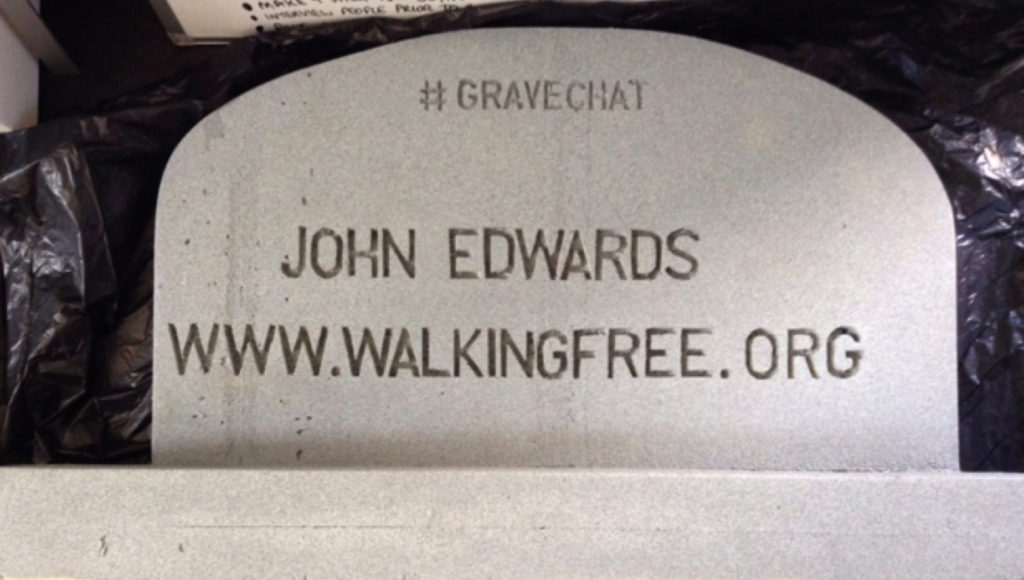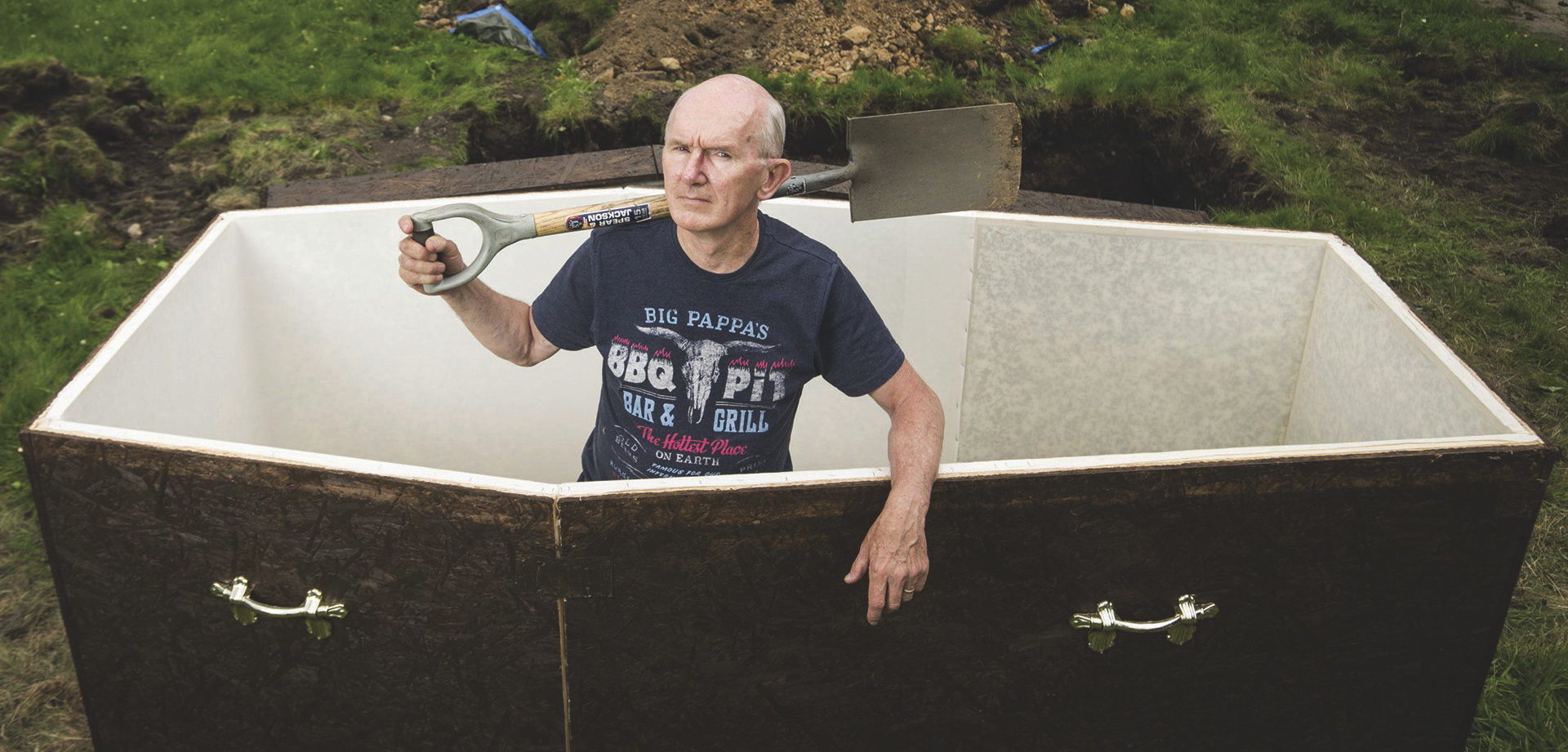Going
underground
People are most interested in how he went to the toilet but former homeless addict John Edwards had serious intent when he was buried alive
It’s most people’s worst nightmare – being buried alive. But John Edwards, a former homeless drug addict, did just that for three days and three nights.
Earlier this year, Edwards kissed his wife goodbye and took a step into his specially made coffin. The lid was lowered, everything went dark and he heard a layer of soil being scattered on top.
“That was really freaky,” he admits. “I was thinking, one day I’m going to be in one of these coffins and my body won’t come out again.”
“Lonely, suicidal people contacted me from all over the world – Mexico, Albania, Australia.”
Edwards, who has been sober for 26 years and set up the charity Walking Free, did the stunt in the grounds of a church in east Belfast, in a bid to stop people losing their lives to addiction. It was his way of “speaking to people beyond the grave”. And it’s not the first time he’s done something so outlandish – he also spent three days buried underground in his adopted town of Halifax last year.
The 72 year old wants to prevent people who are lonely, depressed or addicted to drugs and alcohol from “going into a premature grave”.
“I thought, if I want to stop people going into a grave, I’ve got to go in before them and talk to them from there.”
Edwards shared his experience on social media, live-streaming his time underground using #gravechat, so people could connect from around the world. “Technology can alienate people, but it can really connect people, too.”
The campaign, he says, reached thousands of people. There was a huge response on social media. The downside was that it was very tiring.
“I barely got any sleep down there – about six hours over three days. Lonely, suicidal people contacted me from all over the world – Mexico, Albania, Australia – calling at all hours of the
day and night. I acted as a counsellor to them. It was very tiring, but very rewarding, too.”
The custom-made coffin was bigger than average – 8ft long, 3.5ft high and 4ft wide. And unlike most coffins, his came equipped with all the mod cons.
“It was quite comfortable down there. I had a duvet and a memory foam mattress, a light, and fibre-optic broadband. I took a thermos flask in, so my wife Trisha kept me supplied with hot drinks. I had a little shelf for tea. It wasn’t meant to be an endurance test.”
Edwards’s intentions may have been altruistic, but the first question people have isn’t about the charitable side of things but how he dealt with calls of nature. “People always want to know how I went to the toilet. For a start, I didn’t eat much before I went in, so luckily, I didn’t have to do a number two. There was a camper-style toilet and the coffin was designed with tubes out the top – food came in one and I sent waste out the other.”
Edwards, who was born to a middle-class family in Dublin, set up Walking Free after getting clean age 36. “I used to have a very serious problem with drink and drugs. In the early 1970s my father had to section me. I’d been my parents’ pride and joy and it devastated them.”

He says he takes “full responsibility” for the fact he ended up an addict. “I was 12 when I first stole a Valium tablet from my mum’s handbag. Taking it helped my terrible stammer and gave me more courage. That was the start of it. Twenty years later I was taking up to 150 Valium a day. I progressed from Valium to cannabis to LSD and eventually to barbiturates, which are the drugs they use in assisted suicides. We injected them into our veins. I was totally addicted to them.”
Edwards beat cancer twice and had a liver transplant. “I never tried to commit suicide but I overdosed more than 20 times. I was in a coma for four days and I almost died.”
The day of his father’s funeral was his rock bottom. “My dad died and my family didn’t want me at the funeral, because I’d upset everybody.” He knew that day that he had a choice: suicide or life. “I couldn’t go any lower and I couldn’t take anymore.” He went to rehab and stopped drinking, smoking and taking drugs. That was 26 years ago. “After that, I dedicated my life to helping others.”
“These days there’s a lot of hardship. We might have prosperity, but there’s lots of pressure. People live in darkness. Society doesn’t teach people how to walk in darkness, it doesn’t teach people how to see in the dark. But after what I’ve been through, I can tell where the light is at the end of the tunnel. I’m not afraid to go into people’s darkness, take them by the hand, until they can see the light at the end of their tunnel. There’s no such thing as a hopeless case. By reaching out to people and sharing your problems, there will always be help there.”
Edwards’s biggest fear while in the coffin was that a rat might jump down one of the holes. “I got a bit paranoid about that. I thought I’d have to catch it and kill it. I couldn’t share a coffin with a rat. I had a little stick down there so I could knock a rodent out.”
During the three days and nights, he had to keep himself very focussed or risk flipping out. “Your mind tries to go to a place of claustrophobia, of panic attacks. I learnt to not let my mind go there. It’s a challenge, especially when you get very tired.” He says that as much as he laughs about it, he’s not superman. “It was a long time to be underground.”
When he did sleep, he had strange dreams about the world he’d left behind. “One in particular I remember: I was at a friend’s house and it was summer, and I was in their back garden, and there was a barbecue. I was laughing and enjoying myself. Then I woke up and I was in the coffin. I thought” ‘Oh, my God.’ That freaked me out a bit.”
Edwards admits that the best things about emerging into the world again were the simple things. “It was quite surreal to come out. I was a bit tearful. It was nice to give my wife a cuddle. It was nice to go to the toilet. I was very glad to be above ground again.”
And how do people react when he tells them what he’s done? “People think I’m off my trolley but, for the sake of reaching out to people, I wanted to do it.”
People also told him this couldn’t be done. “You should see my risk assessment and insurance,” he jokes.
Did he ever question his sanity? “People call me nuts, but I say I’m screwed to the right bolt. To be creative, you have to be a bit on the edge.”

Leave a reply
Your email address will not be published.